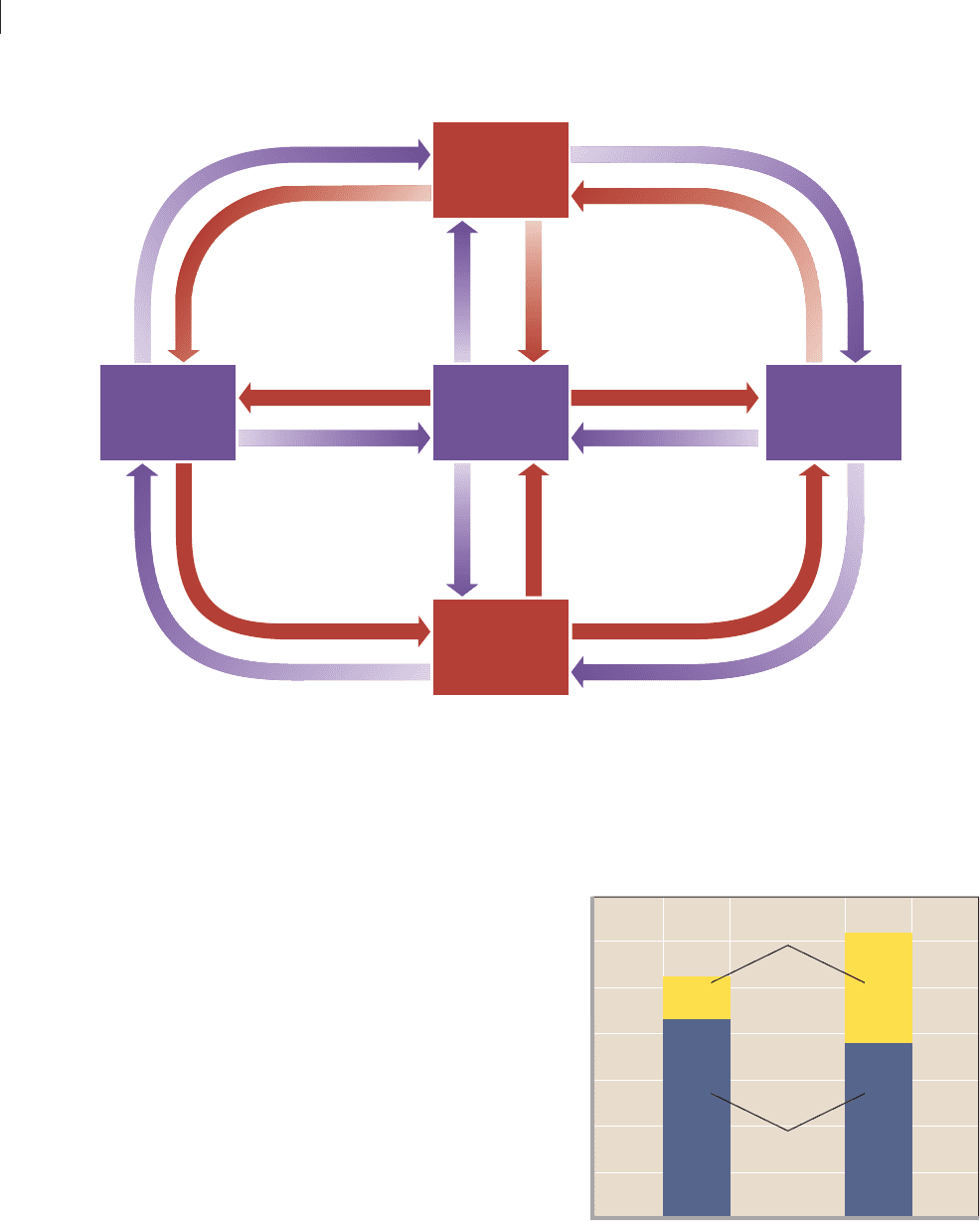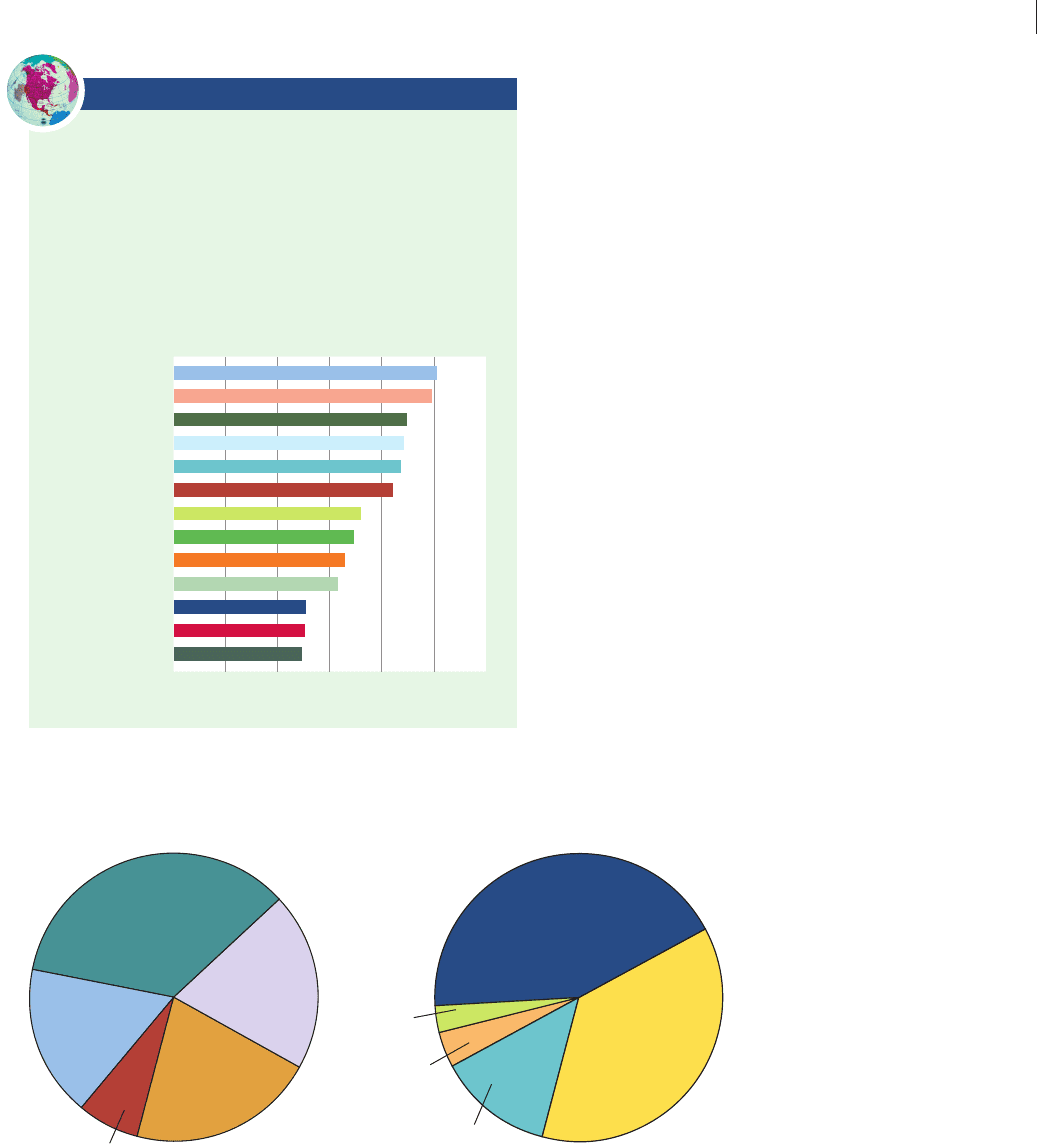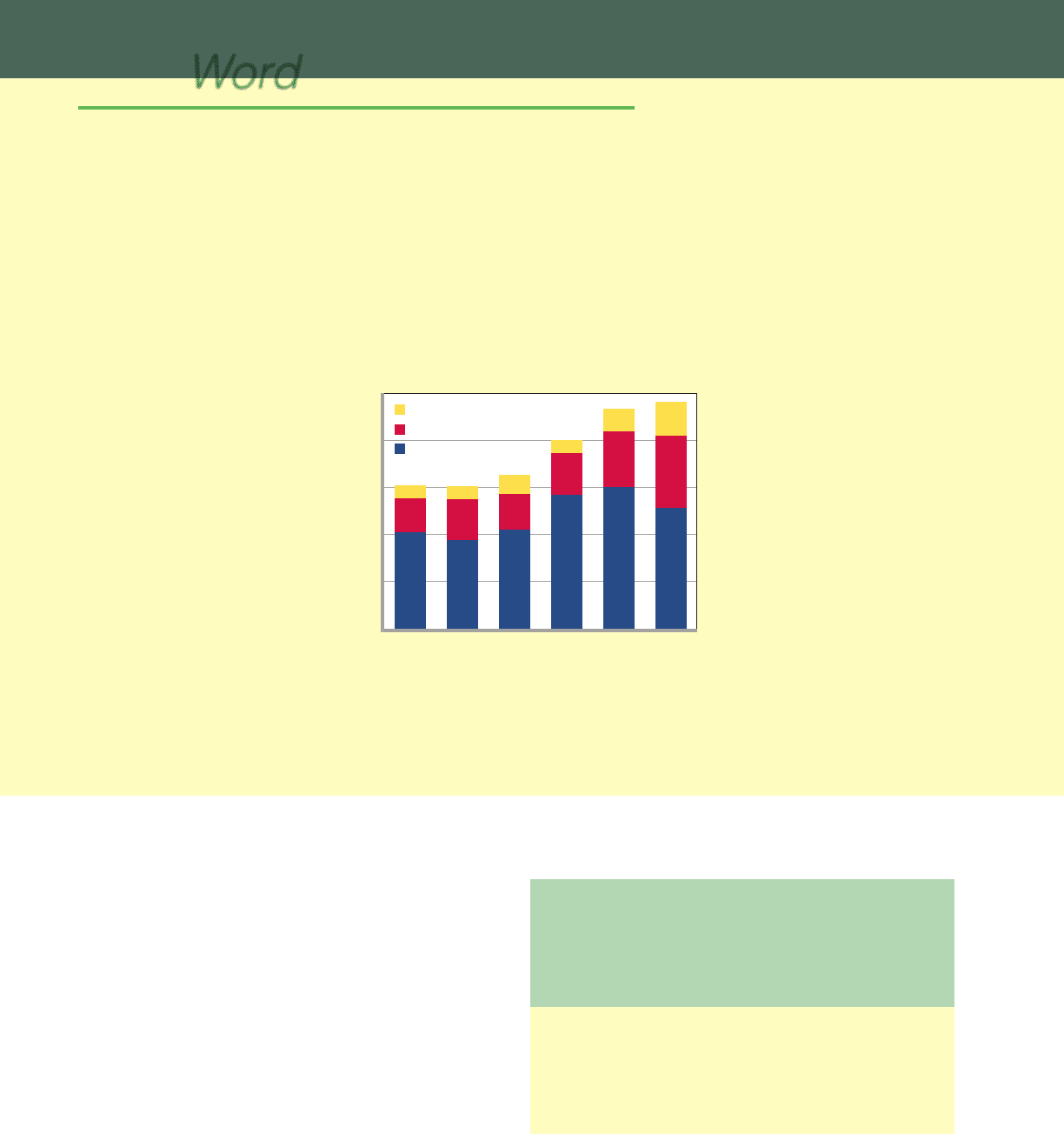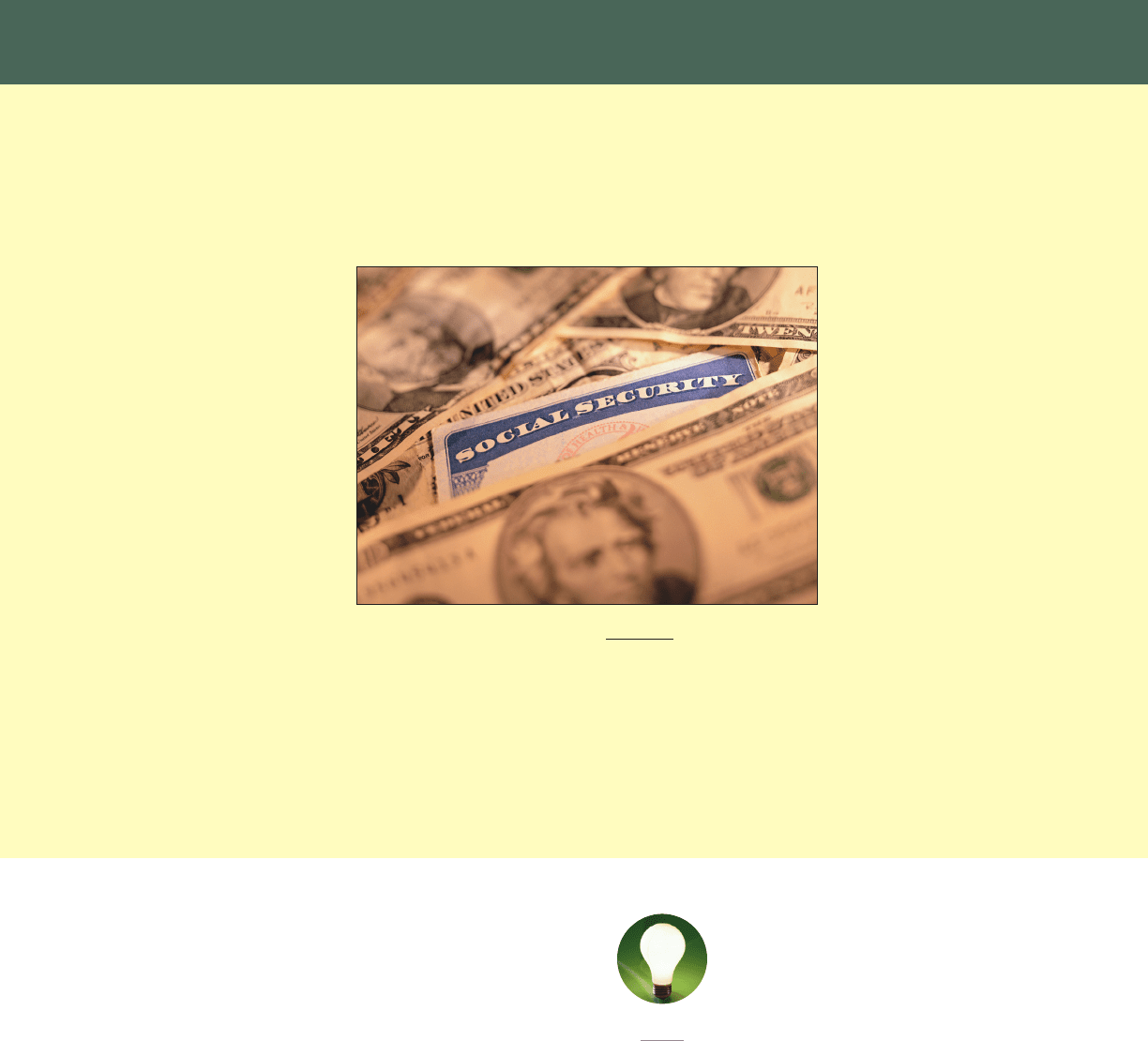McConnell С., Campbell R. Macroeconomics: principles, problems, and policies, 17th ed
Подождите немного. Документ загружается.


CHAPTER 4
The U.S. Economy: Private and Public Sectors
73
Correcting for Positive Externalities How might
the underallocation of resources associated with spillover
benefits be corrected? The answer is either to subsidize
consumers (to increase demand), to subsidize producers
(to increase supply), or, in the extreme, to have govern-
ment produce the product:
• Subsidize consumers To correct the underallocation
of resources to higher education, the U.S. govern-
ment provides low-interest loans to students so that
they can afford more education. Those loans increase
the demand for higher education.
• Subsidize suppliers In some cases government finds
it more convenient and administratively simpler to
correct an underallocation by subsidizing suppliers.
For example, in higher education, state governments
provide substantial portions of the budgets of public
colleges and universities. Such subsidies lower the
costs of producing higher education and increase its
supply. Publicly subsidized immunization programs,
hospitals, and medical research are other examples.
• Provide goods via government A third policy option
may be appropriate where positive externalities are
extremely large: Government may finance or, in the
extreme, own and operate the industry that is in-
volved. Examples are the U.S. Postal Service and
Federal aircraft control systems.
Public Goods and Services Certain goods called
private goods are produced through the competitive market
system. Examples are the wide variety of items sold in
stores. Private goods have two characteristics— rivalry and
excludability . “Rivalry” means that when one person buys
and consumes a product, it is not available for purchase
and consumption by another person. What Joan gets, Jane
cannot have. Excludability means that buyers who are will-
ing and able to pay the market price for the product obtain
its benefits, but those unable or unwilling to pay that price
do not. This characteristic enables profitable production
by a private firm.
Certain other goods and services called public goods
have the opposite characteristics— nonrivalry and nonex-
cludability . Everyone can simultaneously obtain the benefit
from a public good such as a global positioning system,
national defense, street lighting, and environmental pro-
tection. One person’s benefit does not reduce the benefit
available to others. More important, there is no effective
way of excluding individuals from the benefit of the good
once it comes into existence. The inability to exclude cre-
ates a free-rider problem , in which people can receive
benefits from a public good without contributing to its
costs. The free-rider problem makes the good unprofit-
able to provide by a private firm.
An example of a public good is the war on terrorism
(which includes homeland defense and recent military ac-
tions abroad). This public good is thought to be economi-
cally justified by the majority of Americans because the
benefits are perceived as exceeding the costs. Once the
war efforts are undertaken, however, the benefits accrue to
all Americans (nonrivalry). And there is no practical way
to exclude any American from receiving those benefits
(nonexcluability).
No private firm will undertake the war on terrorism
because the benefits cannot be profitably sold (due to the
free-rider problem). So here we have a service that yields
substantial benefits but to which the market system will
not allocate sufficient resources. Like national defense in
general, the pursuit of the war on terrorism is a public
good. Society signals its desire for such goods by voting
for particular political candidates who support their provi-
sion. Because of the free-rider problem, the public sector
provides these goods and finances them through compul-
sory charges in the form of taxes.
Quasi-Public Goods Government provides many
goods that fit the economist’s definition of a public good.
However, it also provides other goods and services that
could be produced and delivered in such a way that exclu-
sion would be possible. Such goods, called quasi-public
goods , include education, streets and highways, police
and fire protection, libraries and museums, preventive
medicine, and sewage disposal. They could all be priced
and provided by private firms through the market system.
But, as we noted earlier, because they all have substantial
positive externalities, they would be underproduced by the
market system. Therefore, government often provides
them to avoid the underallocation of resources that would
otherwise occur.
The Reallocation Process How are resources
reallocated from the production of private goods to the
production of public and quasi-public goods? If the re-
sources of the economy are fully employed, government
must free up resources from the production of private
goods and make them available for producing public and
quasi-public goods. It does so by reducing private demand
for them. And it does that by levying taxes on households
and businesses, taking some of their income out of the cir-
cular flow. With lower incomes and hence less purchasing
power, households and businesses must curtail their con-
sumption and investment spending. As a result, the private
mcc26632_ch04_065-083.indd 73mcc26632_ch04_065-083.indd 73 8/18/06 4:02:47 PM8/18/06 4:02:47 PM
CONFIRMING PAGES

PART ONE
Introduction to Economics and the Economy
74
goods (food, clothing, television sets) and private invest-
ment goods (printing presses, boxcars, warehouses). Gov-
ernment shifts those resources to the production of public
and quasi-public goods (post offices, submarines, parks),
changing the composition of the economy’s total output.
(Key Questions 9 and 10)
Promoting Stability
An economy’s level of output depends on its level of total
spending relative to its production capacity. When the
level of total spending matches the economy’s production
capacity, human and property resources are fully employed
and prices in general are stable. But sometimes total
spending is either inadequate or excessive and the result is
either unemployment or inflation. Government promotes
stability by addressing these two problems:
• Unemployment When private sector spending is
too low, government may try to augment it so that
total spending—private plus public—is sufficient to
achieve full employment. It does this by increasing
government spending or by lowering taxes to stimu-
late private spending. Also, the nation’s central bank
(Federal Reserve in the United States) often takes
actions to lower interest rates, thereby stimulating
private borrowing and spending.
• Inflation Inflation is a general increase in the level
of prices. Prices of goods and services rise when
spenders try to buy more than the economy’s capac-
ity to produce. When total spending is excessive and
becomes inflationary, government may try to reduce
total spending by cutting its own expenditures or by
raising taxes to curtail private spending. The nation’s
central bank may also take actions to increase interest
rates to reduce private borrowing and spending.
Government’s Role:
A Qualification
Government does not have an easy task in performing
the aforementioned economic functions. In a democ-
racy, government undertakes its economic role in the
context of politics. To serve the public, politicians need
to get elected. To stay elected, officials (presidents, sena-
tors, representatives, mayors, council members, school
board members) need to satisfy their particular constitu-
encies. At best the political realities complicate govern-
ment’s role in the economy; at worst, they produce
undesirable economic outcomes.
In the political context, overregulation can occur in
some cases; underregulation, in others. Income can be re-
distributed to such an extent that incentives to work, save,
CONSIDER THIS . . .
Street
Entertainers
Street entertain-
ers are often
found in tourist
areas of major
cities. Some en-
tertainers are
highly creative
and talented; oth-
ers “need more practice.” But, regardless of talent level, these
entertainers illuminate the concepts of free riders and pub-
lic goods.
Most street entertainers have a hard time earning a living
from their activities (unless event organizers pay them) because
they have no way of excluding nonpayers from the benefits of
their entertainment. They essentially are providing public, not
private, goods and must rely on voluntary payments.
The result is a significant free-rider problem. Only a few in
the audience put money in the container or instrument case,
and many who do so contribute only token amounts. The rest
are free riders who obtain the benefits of the street entertain-
ment and retain their money for purchases that they initiate.
Street entertainers are acutely aware of the free-rider
problem, and some have found creative ways to lessen it. For
example, some entertainers involve the audience directly in
the act. This usually creates a greater sense of audience willing-
ness (or obligation) to contribute money at the end of the
performance.
“Pay for performance” is another creative approach to less-
ening the free-rider problem. A good example is the street
entertainer painted up to look like a statue. When people drop
coins into the container, the “statue” makes a slight movement.
The greater the contributions, the greater the movement. But
these human “statues” still face a free-rider problem: Nonpay-
ers also get to enjoy the acts.
Finally, because talented street entertainers create a festive
street environment, cities or retailers sometimes hire them to
perform. The “free entertainment” attracts crowds of shoppers,
who buy goods from nearby retailers. In these instances the cit-
ies or retailers use tax revenue or commercial funds to pay the
entertainers, in the former case validating them as public goods.
demand for goods and services declines, as does the pri-
vate demand for resources. So by diverting purchasing
power from private spenders to government, taxes remove
resources from private use.
Government then spends the tax proceeds to provide
public and quasi-public goods and services. Taxation re-
leases resources from the production of private consumer
mcc26632_ch04_065-083.indd 74mcc26632_ch04_065-083.indd 74 8/18/06 4:02:47 PM8/18/06 4:02:47 PM
CONFIRMING PAGES

CHAPTER 4
The U.S. Economy: Private and Public Sectors
75
forces, Justice Department lawyers, meat inspectors, and
so on. State and local governments hire and pay teachers,
bus drivers, police, and firefighters. The Federal govern-
ment might also lease or purchase land to expand a mili-
tary base, and a city might buy land on which to build a
new elementary school.
Government then provides public goods and services
to both households and businesses, as shown by flows (9)
and (10). To finance those public goods and services,
businesses and households are required to pay taxes, as
shown by flows (11) and (12). These flows are labeled as
net taxes to indicate that they also include “taxes in re-
verse” in the form of transfer payments to households
and subsidies to businesses. Thus, flow (11) entails vari-
ous subsidies to farmers, shipbuilders, and airlines as well
as income, sales, and excise taxes paid by businesses to
government. Most subsidies to business are “concealed”
in the form of low-interest loans, loan guarantees, tax
concessions, or public facilities provided at prices below
their cost. Similarly, flow (12) includes both taxes (per-
sonal income taxes, payroll taxes) collected by govern-
ment directly from households and transfer payments
such as welfare payments and Social Security benefits
paid by government.
Government Finance
How large is the U.S. public sector? What are the main
expenditure categories of Federal, state, and local govern-
ments? How are these expenditures financed?
Government Purchases and
Transfers
We can get an idea of the size of government’s economic
role by examining government purchases of goods and
services and government transfer payments. There is a
significant difference between these two kinds of outlays:
• Government purchases are exhaustive; the
products purchased directly absorb (require the use
of) resources and are part of the domestic output.
For example, the purchase of a missile absorbs the
labor of physicists and engineers along with steel,
explosives, and a host of other inputs.
• Transfer payments are nonexhaustive; they do not
directly absorb resources or create output. Social
Security benefits, welfare payments, veterans’ bene-
fits, and unemployment compensation are examples
of transfer payments. Their key characteristic is that
recipients make no current contribution to domestic
output in return for them.
QUICK REVIEW 4.3
• Government enhances the operation of the market system by
providing an appropriate legal foundation and promoting
competition.
• Transfer payments, direct market intervention, and taxation
are among the ways in which government can lessen income
inequality.
• Government can correct for the overallocation of resources
associated with negative externalities through legislation or
taxes; it can offset the underallocation of resources
associated with positive externalities by granting government
subsidies.
• Government provides certain public goods for which there is
nonrivalry in consumption and nonexcludability of benefits;
government also provides many quasi-public goods because
of their large external benefits.
• To try to stabilize the economy, the government can adjust its
spending and tax revenues and the nation’s central bank can
take monetary actions that lower or increase interest rates.
and invest suffer. Some public goods and quasi-public
goods can be produced not because their benefits exceed
their costs but because their benefits accrue to firms
located in states served by powerful elected officials. Inef-
ficiency can easily creep into government activities because
of the lack of a profit incentive to hold down costs. Poli-
cies to correct negative externalities can be politically
blocked by the very parties that are producing the spill-
overs. In short, the economic role of government, although
critical to a well-functioning economy, is not always per-
fectly carried out.
The Circular Flow Revisited
In Figure 4.6 we integrate government into the circular
flow model first shown in Figure 2.2. Here flows (1)
through (4) are the same as the corresponding flows in
that figure. Flows (1) and (2) show business expenditures
for the resources provided by households. These expendi-
tures are costs to businesses but represent wage, rent, in-
terest, and profit income to households. Flows (3) and (4)
show household expenditures for the goods and services
produced by businesses.
Now consider what happens when we add govern-
ment. Flows (5) through (8) illustrate that government
makes purchases in both product and resource markets.
Flows (5) and (6) represent government purchases of such
products as paper, computers, and military hardware from
private businesses. Flows (7) and (8) represent government
purchases of resources. The Federal government employs
and pays salaries to members of Congress, the armed
mcc26632_ch04_065-083.indd 75mcc26632_ch04_065-083.indd 75 8/18/06 4:02:48 PM8/18/06 4:02:48 PM
CONFIRMING PAGES

PART ONE
Introduction to Economics and the Economy
76
Federal, state, and local governments spent $3876
billion in 2005. Of that total, government purchases were
$2360 billion and government transfers were $1516 billion.
Figure 4.7 shows these amounts as percentages of U.S. do-
mestic output for 2005 and compares them to percentages
for 1960. Government purchases have declined from about
22 to 19 percent of output since 1960. But transfer pay-
ments have more than doubled as a percentage of out-
put—from 5 percent in 1960 to 12 percent in 2005.
Relative to U.S. output, total government spending is thus
higher today than it was 45 years ago. This means that the
tax revenues required to finance government expenditures
are also higher. Today, government spending and the tax
revenues needed to finance it are about 31 percent of U.S.
output.
In 2006 the so-called Tax Freedom Day in the United
States was April 26. On that day the average worker had
earned enough (from the start of the year) to pay his or
her share of the taxes required to finance government
spending for the year. Tax Freedom Day arrives even
FIGURE 4.6 The circular flow and the public sector. Government buys products from the product market and employs
resources from the resource market to provide public goods and services to households and businesses. Government finances its expenditures
through the net taxes (taxes minus transfer payments) it receives from households and businesses.
BUSINESSES
RESOURCE
MARKET
HOUSEHOLDS
PRODUCT
MARKET
GOVERNMENT
(10)
Goods and services
(7)
Expenditures
(8)
Resources
(9)
Goods and services
Net taxes
(11)
Net taxes
(12)
(5)
Expenditures
(6)
Goods and
services
(2) Land, labor, cap
i
t
a
l
,
(1) Costs
(2) Resources
G
o
o
d
s
and services
(4)
(3) Revenue
(
4
)
G
o
o
d
s
a
n
d
s
e
r
v
i
c
e
s
(
3
)
C
o
n
s
u
m
p
t
i
o
n
e
x
p
e
n
d
i
t
u
r
e
s
(1) Money income
(
r
e
n
t
s
,
w
a
g
e
s
,
i
n
t
e
r
e
s
t
,
p
r
o
f
i
t
s
)
entrepreneurial ability
FIGURE 4.7 Government purchases, transfers, and
total spending as percentages of U.S. output, 1960 and
2005. Government purchases have declined as a percentage of U.S. output
since 1960. Transfer payments, however, have increased, so total government
spending (purchases plus transfers) is now 31 percent of U.S. output.
Percentage of U.S. output
Year
15
10
5
0
20
25
30
35
2005
1960
Government
purchases
Government
transfer paymen ts
mcc26632_ch04_065-083.indd 76mcc26632_ch04_065-083.indd 76 8/18/06 4:02:48 PM8/18/06 4:02:48 PM
CONFIRMING PAGES

CHAPTER 4
The U.S. Economy: Private and Public Sectors
77
GLOBAL PERSPECTIVE 4.2
Total Tax Revenue as a Percentage of Total
Output, Selected Nations
The percentage of tax revenues to total output is one measure
of a country’s tax burden. Among the world’s industrialized na-
tions, South Korea, Japan, the United States, and Australia have
the lowest tax burdens.
Source: Organization for Economic Cooperation and Development,
www.oecd.org.
Total Tax Revenues as
Percentage of GDP, 2004
2010 30 40 50
Sweden
Denmark
Norway
France
Finland
Italy
Germany
Canada
United Kingdom
Australia
United States
South Korea
Japan
later in several other countries, as implied in Global Per-
spective 4.2.
Federal Finance
Now let’s look separately at each of the Federal, state, and
local units of government in the United States and com-
pare their expenditures and taxes. Figure 4.8 tells the story
for the Federal government.
Federal Expenditures
Four areas of Federal spending stand out: (1) pensions
and income security, (2) national defense, (3) health, and
(4) interest on the public debt. The pensions and income
security category includes the many income-maintenance
programs for the aged, persons with disabilities or handi-
caps, the unemployed, the retired, and families with no
breadwinner. This category—dominated by the $432 bil-
lion annual Social Security program—accounts for 35 per-
cent of total Federal expenditures. (This chapter’s Last
Word examines the impact of the aging U.S. population
on the future financing of this area of Federal spending.)
National defense accounts for about 20 percent of the
Federal budget, underscoring the high cost of military
preparedness. Health reflects the cost of government
health programs for the retired (Medicare) and poor
(Medicaid). Interest on the public debt is high because the
public debt itself is large.
Federal Tax Revenues
The revenue side of Figure 4.8 shows that the personal
income tax, payroll taxes, and the corporate income tax are
the basic revenue sources, accounting respectively for 43,
37, and 13 cents of each dollar collected.
FIGURE 4.8 Federal expenditures
and tax revenues, 2005. Federal
expenditures are dominated by spending for
pensions and income security, health, and national
defense. A full 84 percent of Federal tax revenue is
derived from just two sources: the personal
income tax and payroll taxes. The $318 billion
difference between expenditures and revenues
reflects a budget deficit.
National
defense
20%
Health
21%
Pensions &
income security
35%
Total expenditures:
$2472 billion
All other
17%
Interest on
public debt
7%
Personal
income tax
43%
Payroll
taxes
37%
Corporate
income tax
13%
Excise
taxes
3%
All other
4%
Total tax revenues:
$2154 billion
Source: U.S. Office of Management and Budget.
mcc26632_ch04_065-083.indd 77mcc26632_ch04_065-083.indd 77 8/18/06 4:02:57 PM8/18/06 4:02:57 PM
CONFIRMING PAGES

PART ONE
Introduction to Economics and the Economy
78
Financing Social Security
There Is a Severe Long-Run Shortfall in Social
Security Funding because of Growing Payments to
Retiring Baby Boomers.
The Social Security program (excluding Medicare) has grown
from less than one-half of 1 percent of U.S. GDP in 1950 to
4.2 percent of GDP today. That percentage is projected to
grow to 6.2 percent of GDP in 2030 and slightly higher
thereafter.
The $432 billion Social Security program is largely an an-
nual “pay-as-you-go” plan, meaning
that most of the current revenues
from the 12.4 percent Social Security
tax (the rate when the 2.9 percent
Medicare tax is excluded) are paid
out to current Social Security retir-
ees. In anticipation of the large ben-
efits owed to the baby boomers when
they retire, however, the Social Se-
curity Administration has been plac-
ing an excess of current revenues
over current payouts into a trust
fund consisting of U.S. Treasury se-
curities. But the accumulation of
money in the Social Security trust
fund will be greatly inadequate for paying the retirement ben-
efits promised to all future retirees.
In 2017 Social Security retirement revenues will fall below
Social Security retirement benefits and the system will begin
dipping into the trust fund to make up the difference. The trust
fund will be exhausted in 2040, after which the promised retire-
ment benefits will immediately exceed the Social Security tax
revenues by an estimated 35 percent annually, rising to 43
percent annually in 2080. The Federal government faces a
several-trillion-dollar shortfall of long-run revenues for funding
Social Security.
As shown in the accompanying figure, the problem is one
of demographics. The percentage of the American population
age 62 or older will rise substantially over the next several
decades, with the greatest increases
for those age 75 and older. High
fertility rates during the “baby
boom” (1946–1964), declining
birthrates thereafter, and rising life
expectancies have combined to pro-
duce an aging population. In the
future, more people will be receiving
Social Security benefits for longer
periods and each person’s benefits
will be paid for by fewer workers.
The number of workers per Social
Security beneficiary was 5:1 in 1960.
Today it is 3:1, and by 2040 it will
be only 2:1.
There is no easy way to restore long-run balance to Social
Security funding. Either benefits must be reduced or revenues
must be increased. The Social Security Administration con-
cludes that bringing projected Social Security revenues and
0
5
10
15
20
25
1990 2000 2010 2020 2030 2040
Ages 85ⴙ
Ages 75–84
Ages 62–74
Percentage of population
Year
Personal Income Tax The personal income tax is
the kingpin of the Federal tax system and merits special
comment. This tax is levied on taxable income, that is, on
the incomes of households and unincorporated businesses
after certain exemptions ($3300 for each household mem-
ber) and deductions (business expenses, charitable contri-
butions, home mortgage interest payments, certain state
and local taxes) are taken into account.
The Federal personal income tax is a progressive tax,
meaning that people with higher incomes pay a larger per-
centage of their incomes as taxes than do people with
lower incomes. The progressivity is achieved by applying
higher tax rates to successive layers or brackets of income.
Columns 1 and 2 in Table 4.1 show the mechanics of
the income tax for a married couple filing a joint return in
Last
Word
78
TABLE 4.1 Federal Personal Income Tax Rates, 2006
*
(4)
Average
(3) Tax Rate
(1) (2) To t a l Ta x on Highest
Total Marginal on Highest Income in
Ta x a b l e Tax Income In Bracket,%
Income Rate,% Bracket (3) ⴜ (1)
$1ⴚ$15,100 10.0 $ 1510 10.0
$15,101ⴚ$61,300 15.0 8440 13.8
$61,301ⴚ$123,700 25.0 24,040 19.4
$123,701ⴚ$188,450 28.0 42,170 22.4
$188,451ⴚ$336,550 33.0 91,043 27.1
Over $336,550 35.0
*For a married couple filing a joint return.
mcc26632_ch04_065-083.indd 78mcc26632_ch04_065-083.indd 78 8/18/06 4:03:07 PM8/18/06 4:03:07 PM
CONFIRMING PAGES

payments into balance over the next 75 years would require a
13 percent permanent reduction in Social Security benefits, a
16 percent permanent increase in tax revenues, or some com-
bination of the two.*
Several ideas have been offered to improve the financial
outlook of Social Security. One idea is to boost the trust fund by
investing all or part of it in corporate stocks and bonds. The
Federal government would
own the stock investments, and
an appointed panel would
oversee the direction of those
investments. The presumed
higher returns on the invest-
ments relative to the lower re-
turns on U.S. securities would
stretch out the life of the trust
fund. Nevertheless, a substan-
tial increase in the payroll tax
would still be needed to cover
the shortfalls after the trust
fund is exhausted.
Another option is to in-
crease the payroll tax immedi-
ately—perhaps by as much as 1.5 percentage points—and
allocate the new revenues to individual accounts. Government
would own the accumulations in the accounts, but individuals
could direct their investments to a restricted list of broad stock
or bond funds. When they retire, recipients could convert these
individual account balances to annuities—securities paying
monthly payments for life. That annuity income would supple-
ment reduced monthly benefits from the pay-as-you-go system
when the trust fund is exhausted.
A different route is to place half the payroll tax into accounts
that individuals, not the government, would own, maintain, and
bequeath. Individuals could invest these funds in bank certificates
of deposit or in approved stock and bond funds and draw upon the
accounts when they reach retirement age. A flat monthly benefit
would supplement the accumulations in the private accounts. The
personal security accounts would be phased in over time, so those
individuals now receiving or
about to receive Social Security
benefits would continue to re-
ceive benefits.
These general ideas do not
exhaust the possible reforms
since the variations on each plan
are nearly endless. Reaching
consensus on Social Security re-
form will be difficult because ev-
ery citizen has a direct economic
stake in the outcome. Neverthe-
less, society will eventually need
to confront the problem of tril-
lions of dollars of unfunded So-
cial Security liabilities.
2006. Note that a 10 percent tax rate applies to all taxable
income up to $15,100 and a 15 percent rate applies to ad-
ditional income up to $61,300. The rates on additional
layers of income then go up to 25, 28, 33, and 35 percent.
The tax rates shown in column 2 in Table 4.1 are mar-
ginal tax rates. A marginal tax rate is the rate at which the
tax is paid on each additional unit of taxable income. Thus,
if a couple’s taxable income is $80,000, they will pay the
marginal rate of 10 percent on each dollar from $1
to $15,100, 15 percent on each dollar from $15,101 to
$61,300, and 25 percent on each dollar from $61,301 to
$80,000. You should confirm that their total income tax is
$13,115.
The marginal tax rates in column 2 overstate the per-
sonal income tax bite because the rising rates in that col-
*Social Security Board of Trustees. “Status of the Social Security
and Medicare Programs: A Summary of the 2006 Annual Reports.”
www.ssa.gov.
†
Medicare (the health insurance that accompanies Social Security) is also
severely underfunded. To bring projected Medicare revenues and expen-
ditures into long-run balance would require an immediate increase in the
Medicare payroll tax by 121 percent, a 51 percent reduction of Medicare
payments from their projected levels, or some combination of each. The
total unfunded liabilities of Social Security and Medicare were $10
trillion in 2005.
umn apply only to the income within each
successive tax bracket. To get a better idea
of the tax burden, we must consider aver-
age tax rates. The average tax rate is the
total tax paid divided by total taxable in-
come. The couple in our previous example
is in the 25 percent tax bracket because
they pay a top marginal tax rate of 25
percent on the highest dollar of their income. But their
average tax rate is 16.4 percent (⫽ $13,115兾$80,000).
A tax whose average rate rises as income increases is a
progressive tax. Such a tax claims both a larger absolute
amount and a larger proportion of income as income rises.
Thus we can say that the Federal personal income tax is
progressive. (Key Question 15)
79
W 4.1
Taxes and
progressivity
mcc26632_ch04_065-083.indd 79mcc26632_ch04_065-083.indd 79 8/18/06 4:03:11 PM8/18/06 4:03:11 PM
CONFIRMING PAGES

PART ONE
Introduction to Economics and the Economy
80
leaves about 19 percent of all state spending for a variety
of other purposes.
These tax and expenditure percentages combine data
from all the states, so they reveal little about the finances
of individual states. States vary significantly in the taxes
levied. Thus, although personal income taxes are a major
source of revenue for all state governments combined,
seven states do not levy a personal income tax. Also, there
are great variations in the sizes of tax revenues and dis-
bursements among the states, both in the aggregate and as
percentages of personal income.
Thirty-nine states augment their tax revenues with
state-run lotteries to help close the gap between their tax
receipts and expenditures. Individual states also receive
large intergovernmental grants from the Federal govern-
ment. In fact, about 28 percent of their total revenue is in
that form. States also take in revenue from miscellaneous
sources such as state-owned utilities and liquor stores.
Local Finances
The local levels of government include counties, munici-
palities, townships, and school districts as well as cities and
towns. Local governments obtain about 73 percent of
their tax revenue from property taxes . Sales and excise
taxes contribute about 17 percent of all local government
tax revenue.
About 44 percent of local government expenditures
go to education. Welfare, health, and hospitals (12 per-
cent); public safety (11 percent); housing, parks, and sew-
erage (8 percent); and streets and highways (5 percent) are
also major spending categories.
The tax revenues of local government cover less than
one-half of their expenditures. The remaining revenue
comes from intergovernmental grants from the Federal
and state governments. Also, local governments receive
considerable amounts of proprietary income, for example,
revenue from government-owned utilities providing wa-
ter, electricity, natural gas, and transportation.
Payroll Taxes Social Security contributions are
payroll taxes —taxes based on wages and salaries—used to
finance two compulsory Federal programs for retired
workers: Social Security (an income-enhancement
program) and Medicare (which pays for medical services).
Employers and employees pay these taxes equally. Im-
provements in, and extensions of, the Social Security
programs, plus growth of the labor force, have resulted in
significant increases in these payroll taxes in recent years.
In 2006, employees and employers each paid 7.65 percent
on the first $94,200 of an employee’s annual earnings and
1.45 percent on all additional earnings.
Corporate Income Tax The Federal government
also taxes corporate income. The corporate income tax
is levied on a corporation’s profit—the difference between
its total revenue and its total expenses. For almost all cor-
porations, the tax rate is 35 percent.
Excise Taxes Taxes on commodities or on purchases
take the form of sales and excise taxes . The difference
between the two is mainly one of coverage. Sales taxes fall
on a wide range of products, whereas excises are levied
individually on a small, select list of commodities. As Fig-
ure 4.8 suggests, the Federal government collects excise
taxes (on the sale of such commodities as alcoholic bever-
ages, tobacco, and gasoline) but does not levy a general
sales tax; sales taxes are the primary revenue source of
most state governments.
State and Local Finance
State and local governments have different mixes of revenues
and expenditures than the Federal government has.
State Finances
The primary source of tax revenue for state governments
is sales and excise taxes, which account for about 48 per-
cent of all their tax revenue. State personal income taxes,
which have much lower rates than the Federal income tax,
are the second most important source of state tax revenue.
They bring in about 34 percent of total state tax revenue.
Corporate income taxes and license fees account for most
of the remainder of state tax revenue.
Education expenditures account for about 35 per-
cent of all state spending. State expenditures on public
welfare are next in relative weight, at about 28 percent
of the total. States also spend heavily on health and hos-
pitals (7 percent), highway maintenance and construc-
tion (7 percent), and public safety (4 percent). That
QUICK REVIEW 4.4
• Government purchases account for about 19 percent of U.S.
output; the addition of transfers increases government
spending to about 31 percent of domestic output.
• Income security and national defense are the main categories
of Federal spending; personal income, payroll, and corporate
income taxes are the primary sources of Federal revenue.
• States rely on sales and excise taxes for revenue; their
spending is largely for education and public welfare.
• Education is the main expenditure for local governments,
most of whose revenue comes from property taxes.
mcc26632_ch04_065-083.indd 80mcc26632_ch04_065-083.indd 80 8/18/06 4:03:12 PM8/18/06 4:03:12 PM
CONFIRMING PAGES

Summary
1. The functional distribution of income shows how society’s
total income is divided among wages, rents, interest, and
profit; the personal distribution of income shows how total
income is divided among individual households.
2. Households use all their income to pay personal taxes, for
saving, and to buy consumer goods. Nearly 60 percent of
their consumption expenditures are for services.
3. Sole proprietorships are firms owned and usually operated
by single individuals. Partnerships are firms owned
and usually operated by just a handful of individuals.
Corporations—the dominant form of business
organization—are legal entities, distinct and separate from
the individuals who own them. They often have thousands,
or even millions, of owners—the stockholders.
4. Corporations finance their operations and purchases of new
plant and equipment partly through the issuance of stocks
and bonds. Stocks are ownership shares of a corporation,
and bonds are promises to repay a loan, usually at a set rate
of interest.
5. A principal-agent problem may occur in corporations when
the agents (managers) hired to represent the interest of the
principals (stockholders) pursue their own objectives to the
detriment of the objectives of the principals.
6. Government improves the operation of the market system
by (a) providing an appropriate legal and social framework
and (b) acting to maintain competition.
7. Government alters the distribution of income through the
tax-transfer system and through market intervention.
8. Externalities, or spillovers, cause the equilibrium output of
certain goods to vary from the socially efficient output.
Negative externalities result in an overallocation of
resources, which can be corrected by legislation or by
specific taxes. Positive externalities are accompanied by an
underallocation of resources, which can be corrected by
government subsidies to consumers or producers.
9. Only government is willing to provide public goods,
which can be consumed by all simultaneously (nonrivalry)
and entail benefits from which nonpaying consumers (free
riders) cannot be excluded (nonexcludability). Because
doing so is not profitable, private firms will not produce
public goods. Quasi-public goods have some of the char-
acteristics of public goods and some of the characteristics
of private goods; government provides them because
the private sector would underallocate resources to
their production.
10. To try to stabilize the economy, the government adjusts its
spending and taxes, and the nation’s central bank (the Fed-
eral Reserve in the United States) uses monetary actions to
alter interest rates.
11. Government purchases exhaust (use up or absorb) resources;
transfer payments do not. Government purchases have de-
clined from about 22 percent of domestic output in 1960 to
19 percent today. Transfer payments, however, have grown
significantly. Total government spending now amounts to
about 31 percent of domestic output.
12. The main categories of Federal spending are pensions and
income security, national defense, health, and interest on
the public debt; Federal revenues come primarily from
personal income taxes, payroll taxes, and corporate in-
come taxes.
13. States derive their revenue primarily from sales and excise
taxes and personal income taxes; major state expenditures
go to education, public welfare, health and hospitals,
and highways. Local communities derive most of their
revenue from property taxes; education is their most
important expenditure.
14. State and local tax revenues are supplemented by sizable
revenue grants from the Federal government.
CHAPTER 4
The U.S. Economy: Private and Public Sectors
81
Terms and Concepts
functional distribution of income
personal distribution of income
durable goods
nondurable goods
services
plant
firm
industry
sole proprietorship
partnership
corporation
stock
bond
limited liability
principal-agent problem
monopoly
externality
negative externalities
positive externalities
public goods
free-rider problem
quasi-public goods
government purchases
transfer payments
personal income tax
marginal tax rate
average tax rate
payroll taxes
corporate income tax
sales and excise taxes
property taxes
mcc26632_ch04_065-083.indd 81mcc26632_ch04_065-083.indd 81 8/18/06 4:03:12 PM8/18/06 4:03:12 PM
CONFIRMING PAGES

PART ONE
Introduction to Economics and the Economy
82
Study Questions
1. Distinguish between the functional distribution and per-
sonal distribution of income. Which is being referred to in
each of the following statements? “The combined share of
wage income and proprietary income has remained remark-
ably stable at about 80 percent since the Second World
War.” “The relative income of the richest households is
higher today than in 1970.”
2.
KEY QUESTION Assume that the five residents of Econoville
receive incomes of $50, $75, $125, $250, and $500. Present
the resulting distribution of income as a graph similar to
Figure 4.2. Compare the incomes of the lowest fifth and the
highest fifth of the income receivers.
3. Distinguish between a plant, a firm, and an industry. Con-
trast a vertically integrated firm, a horizontally integrated
firm, and a conglomerate. Cite an example of a horizontally
integrated firm from which you have recently made a
purchase.
4.
KEY QUESTION What are the three major legal forms of
business organization? Which form is the most prevalent in
terms of numbers? Why do you think that is so? Which
form is dominant in terms of total sales? What major advan-
tages of this form of business organization gave rise to its
dominance?
5. What is the principal-agent problem as it relates to manag-
ers and stockholders? How did firms try to solve it in the
1990s? In what way did the “solution” backfire on some
firms?
6. Identify and briefly describe the main economic functions
of government. What function do you think is the most
controversial? Explain why.
7. What divergences arise between equilibrium output and ef-
ficient output when (a) negative externalities and (b) positive
externalities are present? How might government correct
these divergences? Cite an example (other than the text
examples) of an external cost and an external benefit.
8. Explain why zoning laws, which allow certain land uses only
in specific locations, might be justified in dealing with a
problem of negative externalities. Explain why tax breaks to
businesses that set up in areas of high unemployment might
be justified in view of positive externalities. Explain why ex-
cise taxes on beer might be justified in dealing with a prob-
lem of external costs.
9.
KEY QUESTION What are the two characteristics of public
goods? Explain the significance of each for public provision
as opposed to private provision. What is the free-rider prob-
lem as it relates to public goods? Is U.S. border patrol a
public good or a private good? Why? How about satellite
TV? Explain.
10.
KEY QUESTION Draw a production possibilities curve with
public goods on the vertical axis and private goods on the hor-
izontal axis. Assuming the economy is initially operating on the
curve, indicate how the production of public goods might be
increased. How might the output of public goods be increased
if the economy is initially operating at a point inside the curve?
11. Use the distinction between the characteristics of private
and public goods to determine whether the following should
be produced through the market system or provided by
government: (a) French fries, (b) airport screening, (c) court
systems, (d) mail delivery, and (e) medical care. State why
you answered as you did in each case.
12. Use the circular flow diagram to show how each of the
following government actions simultaneously affects the
allocation of resources and the distribution of income:
a. The construction of a new high school.
b. A 2-percentage-point reduction of the corporate
income tax.
c. An expansion of preschool programs for disadvantaged
children.
d. The levying of an excise tax on polluters.
13. What do economists mean when they say government pur-
chases are “exhaustive” expenditures whereas government
transfer payments are “nonexhaustive” expenditures? Cite
an example of a government purchase and a government
transfer payment.
14. What is the most important source of revenue and the ma-
jor type of expenditure at the Federal level? At the state
level? At the local level?
15.
KEY QUESTION Suppose in Fiscalville there is no tax on
the first $10,000 of income, but a 20 percent tax on
earnings between $10,000 and $20,000 and a 30 percent
tax on income between $20,000 and $30,000. Any income
above $30,000 is taxed at 40 percent. If your income is
$50,000, how much will you pay in taxes? Determine your
marginal and average tax rates. Is this a progressive tax?
Explain.
16.
LAST WORD What do economists mean when they refer to
Social Security as a pay-as-you-go plan? What is the Social
Security trust fund? What is the nature of the long-run fis-
cal imbalance in the Social Security retirement system?
What are the broad options for addressing this problem?
mcc26632_ch04_065-083.indd 82mcc26632_ch04_065-083.indd 82 8/18/06 4:03:12 PM8/18/06 4:03:12 PM
CONFIRMING PAGES
